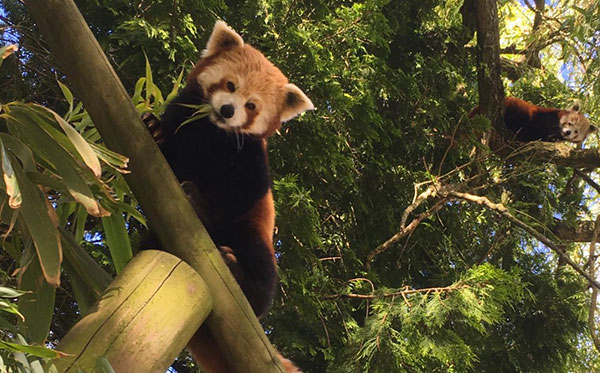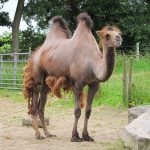It’s Panda Party Time!

It has been a double birthday for our cute and popular red pandas here at the zoo this week. Tai Jang our female turned 5 on the 12th of June whilst our male Bai Jiao also became 5 on the 14th of June! They received their favourite ‘panda cake’ which consists of a variety of nutrients including protein, essential vitamins, minerals and high fibre. However bamboo, fruits, pellets and other leaves make up a majority of their diet.
The name panda is thought to be in reference to the Nepali word ponya from the phrase nigalya ponya, meaning “eater of bamboo”. Just like the giant panda they share a similar diet however are very different in appearance. The red panda are slightly more racoon and look fairly similar however they have a lovely red coat and long bushy tail which they can wrap round themselves like a duvet to keep warm. They can also use their tails for balance as they are very efficient climbers and spend most of their time up in the trees. If you wish to see our red pandas, then that is always the first place to look! They have semi-retractable claws, which also gives them amazing grip and allows them to pull leaves off branches. They originate from the forests and mountain ranges of Nepal, China, Bhutan and India. Their fur helps keep them camouflaged in amongst the red moss in their natural habitat.
Bai Jiao moved here from Cotswold zoo originally, whilst Tai Jang came here from Leipzig Zoo in Germany. They came here as part of the European endangered species programme and previously they have had one cub, which has since moved to another zoo. We train our red pandas every day, encouraging them to come down from the trees, follow a target stick around and be hand fed by our keepers. We do this every day generally around half one which is the best time for our public to see our pandas in action. This allows us to do health checks and weigh them, they both weigh around 5 kilograms. Females tend to be more confident and Tai Jang regularly comes down, touches the target stick with her nose and received a reward. This training technique is called positive reinforcement and can be used for a whole range of species.
Sadly the reason we have a breeding pair of red pandas here at the zoo is because they are an endangered species with fewer than ten thousand left in the wild. They are poached for their fur and also taken from the wild to become part of the illegal pet trade. Habitat loss is another huge factor in their populations decreasing.


